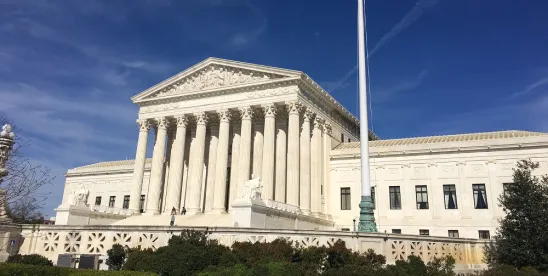WHAT YOU NEED TO KNOW IN A MINUTE OR LESS
One of the earliest modern environmental, social, and governance (ESG) cases decided by the Supreme Court, Massachusetts v. EPA (2007), turned on Article III standing.1 There, the Supreme Court held that the Commonwealth of Massachusetts and other government entities had standing to challenge the U.S. Environmental Protection Agency’s decision not to regulate greenhouse gas emissions.2 However, more recent Supreme Court precedent has placed a renewed emphasis on standing issues in class actions. While these newer developments have yet to fully mature in lower courts, they make standing challenges to ESG class actions even more formidable.
In a minute or less, here is what you need to know.
"No concrete harm, no standing."
In June 2021, the Supreme Court issued TransUnion LLC v. Ramirez,3 which held that “the risk of future harm on its own does not support Article III standing for the plaintiffs’ damages claims.”4 In TransUnion, the parties to a Fair Credit Reporting Act claim had stipulated that the vast majority of the class members’ at-issue credit reports had not been communicated to a third party.5 Since those plaintiffs were uninjured (or at best alleged a speculative, future injury), the Court picked up a line from a Justice Roberts concurrence in a prior case: “‘Article III does not give federal courts the power to order relief to any uninjured plaintiff, class action or not.’”6
In short, as the Court bookended its opinion: “No concrete harm, no standing.”7
While the effects of TransUnion are still working their way through lower courts, issues of uninjured class members are nothing new. To date, circuit courts have taken a myriad of approaches. Some inspect whether a class contains a “great number” of class members who could not have been harmed by the defendant’s conduct.8 Others look to determine whether a class contains more than a de minimis number of uninjured class members,9 and still others hold that a class cannot be certified unless the plaintiffs demonstrate an administratively feasible and fair method for identifying and removing uninjured class members.10
Recent ESG Class Action Without a Leg to Stand On
With issues of uninjured class members developing differently across circuits, and with TransUnion’s guidance still making its way through lower courts, standing issues in ESG class actions were already independently prevalent. However, these ESG class actions have generally focused on the standing inquiry’s traceability requirement, whereas TransUnion and other class actions focused on injury-in-fact.
For example, the United States District Court for the District of Maryland recently dismissed a putative consumer class action against a global hotel and hospitality chain following a data breach.11 The putative class action alleged that the company’s “failure to implement adequate and reasonable cyber-security procedures and protocols necessary to protect its guests’” personal identifying information resulted in the data breach.12 However, the complaint failed to allege any facts describing the company’s “cybersecurity or steps that it could have or should have taken to prevent this data breach.”13
Reciting the familiar Iqbal standard, the court set aside plaintiffs’ “conclusory and nonspecific allegations,” and held that the remaining allegations do not “overcome the need to plead sufficient facts relating to what [the company] did or did not do that led to the injuries claimed.”14 Therefore, the court dismissed the putative class action complaint with prejudice.15
In ESG class actions, the irreducible constitutional minimum of standing is a strong arrow in the class action defense attorney’s quiver. As the law concerning the injury-in-fact requirement continues to develop, companies should be mindful of the available standing arguments that a putative ESG class action poses where the putative class contains many uninjured class members, in addition to the more common arguments regarding traceability.
ENDNOTES
1 Massachusetts v. EPA, 549 U.S. 497 (2007).
-
For a primer on Massachusetts v. EPA, see this Environmental, Land Use and Natural Resources Alert published by our colleagues: U.S. Supreme Court Opens Door to EPA Regulation of Greenhouse Gas Emissions
2 See Massachusetts, 549 U.S. at 526.
3 For more on TransUnion, see our prior U.S. Complex Commercial Litigation and Disputes and Appellate Litigation alert: Where's the Harm in Class Certification? The Supreme Court Confirms: It Must be in Plaintiffs' Evidence
4 TransUnion, 141 S. Ct. 2190, 2213 (2021).
5 Id. at 2202.
6 Id. at 2208 (quoting Tyson Foods, Inc. v. Bouaphakeo, 577 U.S. 442, 466 (2016) (Roberts, J., concurring)).
7 Id. at 2200, 2214.
8 See, e.g., Oshana v. Coca-Cola Co., 472 F.3d 506, 514-15 (7th Cir. 2006) (affirming denial of certification of class that included “millions” of uninjured class members).
9 See, e.g., In re Rail Freight Fuel Surcharge Litig. – MDL No. 1869, 934 F.3d 619, 624-25 (D.C. Cir. 2019) (affirming denial of certification of class where 12.7% of members were uninjured).
10 See, e.g., In re Asacol Antitrust Litig., 907 F.3d 42, 51-57 (1st Cir. 2018) (holding that affidavits from class members containing testimony that defendant genuinely challenges are insufficient).
11 Springmeyer v. Marriott Int’l, Inc., No. 20-867, 2021 WL 809894 (D. Md. Mar. 3, 2021).
12 Id. at *3.
13 Id.
14 Id.
15 Id. at *4.






 />i
/>i

